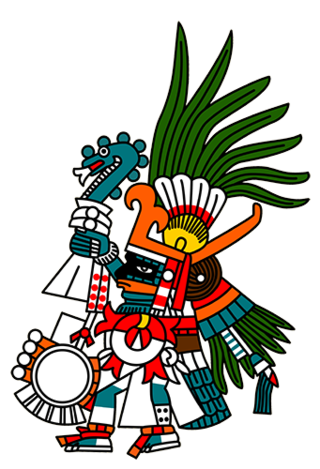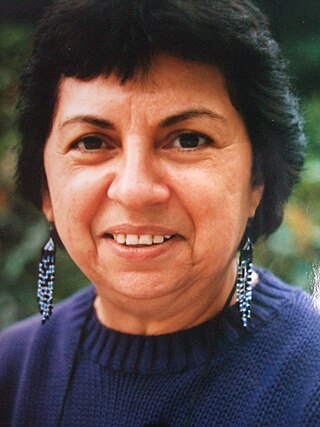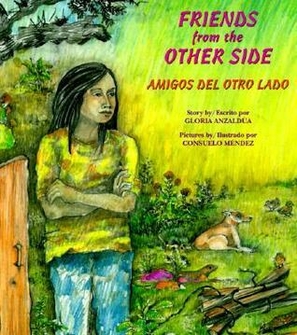
Chicano or Chicana is an ethnic identity for Mexican Americans who have a non-Anglo self-image, embracing their Mexican Native ancestry. Chicano was originally a classist and racist slur used toward low-income Mexicans that was reclaimed in the 1940s among youth who belonged to the Pachuco and Pachuca subculture. In the 1960s, Chicano was widely reclaimed in the building of a movement toward political empowerment, ethnic solidarity, and pride in being of indigenous descent. Chicano developed its own meaning separate from Mexican American identity. Youth in barrios rejected cultural assimilation into the mainstream American culture and embraced their own identity and worldview as a form of empowerment and resistance. The community forged an independent political and cultural movement, sometimes working alongside the Black power movement.

Aztec mythology is the body or collection of myths of the Aztec civilization of Central Mexico. The Aztecs were Nahuatl-speaking groups living in central Mexico and much of their mythology is similar to that of other Mesoamerican cultures. According to legend, the various groups who were to become the Aztecs arrived from the north into the Anahuac valley around Lake Texcoco. The location of this valley and lake of destination is clear – it is the heart of modern Mexico City – but little can be known with certainty about the origin of the Aztec. There are different accounts of their origin. In the myth the ancestors of the Mexica/Aztec came from a place in the north called Aztlan, the last of seven nahuatlacas to make the journey southward, hence their name "Azteca." Other accounts cite their origin in Chicomoztoc, "the place of the seven caves", or at Tamoanchan.

Coatlicue, wife of Mixcōhuātl, also known as Tēteoh īnnān is the Aztec goddess who gave birth to the moon, stars, and Huītzilōpōchtli, the god of the sun and war. The goddesses Toci "our grandmother" and Cihuacōātl "snake woman", the patron of women who die in childbirth, were also seen as aspects of Cōātlīcue.

In Aztec religion, Coyolxāuhqui is a daughter of the priestess Cōātlīcue. She was the leader of her brothers, the Centzon Huitznahua. She led her brothers in an attack against their mother, Cōātlīcue, when they learned she was pregnant, convinced she dishonored them all. The attack is thwarted by Coyolxāuhqui's other brother, Huitzilopochtli, the national deity of the Mexicas.

Huitzilopochtli is the solar and war deity of sacrifice in Aztec religion. He was also the patron god of the Aztecs and their capital city, Tenochtitlan. He wielded Xiuhcoatl, the fire serpent, as a weapon, thus also associating Huitzilopochtli with fire.

In creation myths, the term "Five Suns" refers to the belief of certain Nahua cultures and Aztec peoples that the world has gone through five distinct cycles of creation and destruction, with the current era being the fifth. It is primarily derived from a combination of myths, cosmologies, and eschatological beliefs that were originally held by pre-Columbian peoples in the Mesoamerican region, including central Mexico, and it is part of a larger mythology of Fifth World or Fifth Sun beliefs.

Cherríe Moraga is a Xicana feminist, writer, activist, poet, essayist, and playwright. She is part of the faculty at the University of California, Santa Barbara in the Department of English since 2017, and in 2022 became a distinguished professor. Moraga is also a founding member of the social justice activist group La Red Xicana Indígena, which is network fighting for education, culture rights, and Indigenous Rights. In 2017, she co-founded, with Celia Herrera Rodríguez, Las Maestras Center for Xicana Indigenous Thought, Art, and Social Practice, located on the campus of UC Santa Barbara.

Gloria Evangelina Anzaldúa was an American scholar of Chicana feminism, cultural theory, and queer theory. She loosely based her best-known book, Borderlands/La Frontera: The New Mestiza (1987), on her life growing up on the Mexico–Texas border and incorporated her lifelong experiences of social and cultural marginalization into her work. She also developed theories about the marginal, in-between, and mixed cultures that develop along borders, including on the concepts of Nepantla, Coyoxaulqui imperative, new tribalism, and spiritual activism. Her other notable publications include This Bridge Called My Back: Writings by Radical Women of Color (1981), co-edited with Cherríe Moraga.

The Templo Mayor was the main temple of the Mexica people in their capital city of Tenochtitlan, which is now Mexico City. Its architectural style belongs to the late Postclassic period of Mesoamerica. The temple was called Huēyi Teōcalli in the Nahuatl language. It was dedicated simultaneously to Huitzilopochtli, god of war, and Tlaloc, god of rain and agriculture, each of which had a shrine at the top of the pyramid with separate staircases. The central spire was devoted to Quetzalcoatl in his form as the wind god, Ehecatl. The Great Temple devoted to Huitzilopochtli and Tlaloc, measuring approximately 100 by 80 m at its base, dominated the Sacred Precinct. Construction of the first temple began sometime after 1325, and it was rebuilt six times. The temple was almost totally destroyed by the Spanish in 1521, and the Mexico City cathedral was built in its place.

New tribalism is a theory by queer Chicana feminist Gloria E. Anzaldúa to disrupt the matrix of imposed identity categories that the hegemonic culture imposes on people in order to maintain its power and authority. Anzaldúa states that she "appropriated" and reused the term from David Rieff, who had "used it to criticize [her] for being 'a professional Aztec' and for what he saw as [her] naive and nostalgic return to indigenous roots." Rieff stated that Anzaldúa should "think a little less about race and a little more about class." In response, Anzaldúa developed the concept in order to form an inclusive social identity that "motivates subordinated communities to work together in coalition."

Chicana feminism is a sociopolitical movement, theory, and praxis that scrutinizes the historical, cultural, spiritual, educational, and economic intersections impacting Chicanas and the Chicana/o community in the United States. Chicana feminism empowers women to challenge institutionalized social norms and regards anyone a feminist who fights for the end of women's oppression in the community.

The Aztec religion is a polytheistic and monistic pantheism in which the Nahua concept of teotl was construed as the supreme god Ometeotl, as well as a diverse pantheon of lesser gods and manifestations of nature. The popular religion tended to embrace the mythological and polytheistic aspects, and the Aztec Empire's state religion sponsored both the monism of the upper classes and the popular heterodoxies.

The Coyolxāuhqui Stone is a carved, circular Aztec stone, depicting the mythical being Coyolxāuhqui ("Bells-Her-Cheeks"), in a state of dismemberment and decapitation by her brother, the patron deity of the Aztecs, Huitzilopochtli. It was rediscovered in 1978 at the site of the Templo Mayor of Tenochtitlan, now in Mexico City. This relief is one of the best known Aztec monuments and one of the few great Aztec monuments that have been found fully in situ.

Borderlands/La Frontera: The New Mestiza is a 1987 semi-autobiographical work by Gloria E. Anzaldúa that examines the Chicano and Latino experience through the lens of issues such as gender, identity, race, and colonialism. Borderlands is considered to be Anzaldúa’s most well-known work and a pioneering piece of Chicana literature.

Alma López is a Mexican-born Queer Chicana artist. Her art often portrays historical and cultural Mexican figures, such as the Virgin of Guadalupe and La Llorona, filtered through a radical Chicana feminist lesbian lens. Her art work is meant to empower women and indigenous Mexicans by the reappropriation of symbols of Mexica history when women played a more prominent role. The medium of digital art allows her to mix different elements from Catholicism and juxtapose it to indigenous art, women, and issues such as rape, gender violence, sexual marginalization and racism. This juxtaposition allows her to explore the representation of women and indigenous Mexicans and their histories that have been lost or fragmented since colonization. Her work is often seen as controversial. Currently, she is a lecturer at the University of California Los Angeles in the Department of Chicana/o Studies.

Chicana literature is a form of literature that has emerged from the Chicana Feminist movement. It aims to redefine Chicana archetypes in an effort to provide positive models for Chicanas. Chicana writers redefine their relationships with what Gloria Anzaldúa has called "Las Tres Madres" of Mexican culture by depicting them as feminist sources of strength and compassion.

Friends from the Other Side / Amigos del Otro Lado (1993) is a bilingual (Spanish/English) Latino children's book written by Mexican American/Chicana scholar Gloria E. Anzaldúa and illustrated by Consuelo Méndez Castillo. It is loosely based on Anzaldúa's early life in South Texas and tells the story of a young Chicana girl, Prietita, living near the US-Mexican border who befriends and helps a young Mexican boy, Joaquín, who has recently immigrated.
Queer of color critique is an intersectional framework, grounded in Black feminism, that challenges the single-issue approach to queer theory by analyzing how power dynamics associated race, class, gender expression, sexuality, ability, culture and nationality influence the lived experiences of individuals and groups that hold one or more of these identities. Incorporating the scholarship and writings of Audre Lorde, Gloria Anzaldúa, Kimberlé Crenshaw, Barbara Smith, Cathy Cohen, Brittney Cooper and Charlene A. Carruthers, the queer of color critique asks: what is queer about queer theory if we are analyzing sexuality as if it is removed from other identities? The queer of color critique expands queer politics and challenges queer activists to move out of a "single oppression framework" and incorporate the work and perspectives of differently marginalized identities into their politics, practices and organizations. The Combahee River Collective Statement clearly articulates the intersecting forces of power: "The most general statement of our politics at the present time would be that we are actively committed to struggling against racial, sexual, heterosexual, and class oppression, and see as our particular task the development of integrated analysis and practice based upon the fact that major systems of oppression are interlocking. The synthesis of these oppressions creates the conditions of our lives." Queer of color critique demands that an intersectional lens be applied queer politics and illustrates the limitations and contradictions of queer theory without it. Exercised by activists, organizers, intellectuals, care workers and community members alike, the queer of color critique imagines and builds a world in which all people can thrive as their most authentic selves- without sacrificing any part of their identity.

Spiritual activism is a practice that brings together the otherworldly and inward-focused work of spirituality and the outwardly-focused work of activism. Spiritual activism asserts that these two practices are inseparable and calls for a recognition that the binaries of inward/outward, spiritual/material, and personal/political all form part of a larger interconnected whole between and among all living things. In an essay on queer Chicana feminist and theorist Gloria E. Anzaldúa's reflections on spiritual activist practice, AnaLouise Keating states that "spiritual activism is spirituality for social change, spirituality that posits a relational worldview and uses this holistic worldview to transform one's self and one's worlds."


















